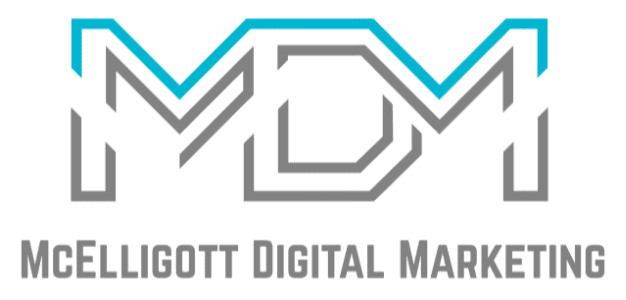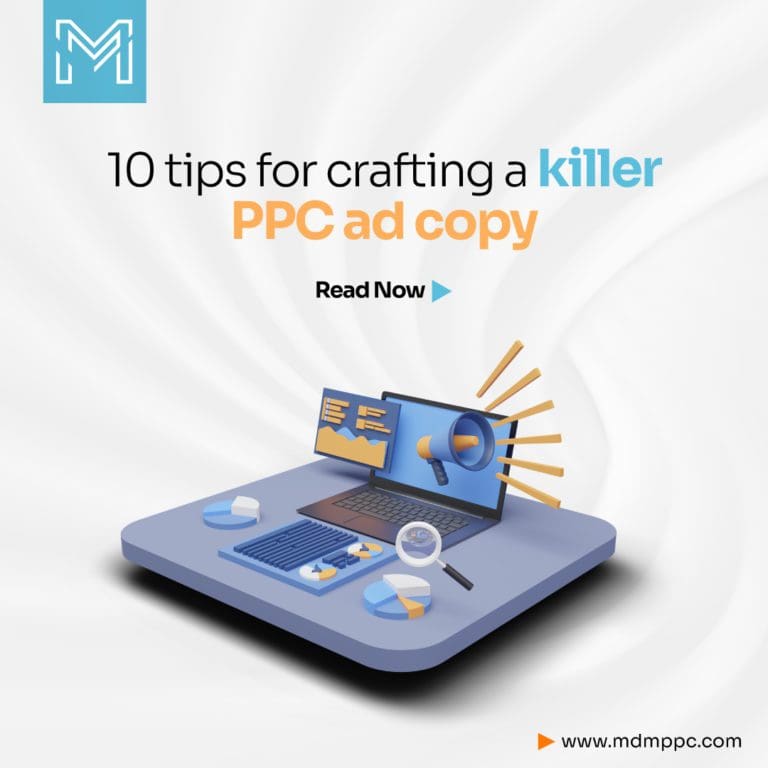The effectiveness of running PPC ads can vary greatly, depending on the quality of your ad text.
Crafting compelling copy for PPC ads is more challenging than it appears, particularly given the limited space available on platforms like Google Ads.
In limited characters, you must capture a potential customer’s attention, pique their interest in your product or service, and persuade them to click through to your website.
If your PPC ads text fails to attract the attention and action of your audience, it can be a good use of time.
If done right, it can be highly profitable for your business in terms of revenue and brand building.
No matter how many features and functions you leverage in AdWords, your return on investment will be limited if your ad copy is subpar. The good news is that the PPC specialists at McElligott Digital Marketing are well-versed in the art of crafting outstanding ad copy.
In this article, we will be sharing our top tips for creating high-performing PPC ad copy.
How do Google Ads look like?
Every advertising platform has its own set of rules and limitations.
Furthermore, most pay-per-click (PPC) platforms provide multiple ad formats, which can make things even more complex. To prevent this article from becoming too lengthy by covering every single ad format, we will concentrate on the Google text ads format.
By focusing on Google text ads, you can obtain a general idea of how PPC ads are constructed and prepare yourself for success on many other advertising platforms.
The components of PPC ad copy are essential and serve specific purposes. Knowing these parts will enable you to implement the strategies covered later in this article and significantly enhance the effectiveness of your ads.
To begin, let’s examine the Google ad format below.
Final URL: This is the URL that visitors will be directed to after clicking your ad. It doesn’t appear in the ad, so all you need to do is input your website or landing page URL.
Headline 1: The primary headline that catches the user’s attention. It should match the user’s search term and the message on your landing page.
Headline 2: The second headline should showcase your unique value proposition or offer. This could be in various forms, and we’ll provide you with numerous examples later in this article.
Headline 3: The third headline may not always be displayed, so you can use it for your brand or other non-essential information.
Display Path: This is not the same as the Final URL and is only for viewing purposes. It doesn’t affect your URL or the landing page, but it can influence a user’s decision to click on your ad. Therefore, it’s important to include your keywords in the display path whenever possible.
Description 1: There’s limited space in the description, so you need to use it wisely. Try to include your keywords and a call to action whenever possible.
Description 2: The second description may not always be displayed, but it’s still important to use it to address potential customer questions and offer a secondary call to action.
In addition to the components of a Google text ad, there is also an unspoken rule for writing ad headlines: they should be written in title case. This means that all words should be capitalized except for non-initial articles like ‘a, ‘the’, ‘and’, etc. Although it may seem odd, following this rule can improve your ad’s performance.
Pro Tip: The numbers next to each field represent the maximum number of characters that can be used in that section.
Try to maximize the character count in each field whenever possible. More characters make your ad larger and more visible in search results, increasing the likelihood of attracting potential customers.
What are Ad extensions?
Google Ad extensions are additional pieces of information that can be appended to your ad, providing more details about your business and products. This can include highlights, relevant links, and pricing information.
These extensions are automatically served with your ad by Google based on the context of the search. They add value to the user experience by providing information that matches user intent, location, or device.
There are currently 10 different manual ad extensions available, each providing unique information about your business. These include:
- Sitelinks
- Callout extensions
- Structured snippets
- Call extensions
- Lead form extensions (beta)
- Location extensions
- Affiliate location extensions
- Price extensions
- App extensions
- Promotion extensions.
Sitelinks, callout extensions, and structured snippets are considered universal extensions and are recommended for use by all advertisers.
How to write a PPC Ad copy that converts?
#1. Know your audience
The key to writing effective ad copy is to focus on your target audience’s needs and problems instead of solely promoting your business.
Your customers are searching for a solution to their problems, not for information about your company. Therefore, it’s important to put yourself in their shoes and understand what they need and how they search for it.
To do this, start by identifying your target audience and their pain points. Think about how they might search for a solution and what kind of language they might use. Then, craft your ad copy to address their needs and offer a solution that is relevant and valuable to them.
By focusing on your customers’ needs and crafting ad copy that speaks directly to them, you’ll increase the chances of capturing their attention and driving conversions.
Additionally, using language that resonates with your target audience can improve the quality score of your ads, which can ultimately lead to lower costs and higher ad rankings.
#2. Perfect the headline
The headlines of your ad are crucial, as they are often the only part that searchers read. Therefore, the performance of your ad can largely depend on the effectiveness of your headlines.
Include the keyword in the headline: The placement of your keyword in the headline is just as critical as including it. This is due to how the human brain processes information.
When presented with a list of words, people tend to remember the first few and last few words but forget those in the middle. Therefore, the first few and last few words of your ad are the most crucial.
In addition, shorter sentences are more memorable than longer ones. Your headline – the first few words that the reader sees – is the most important component of your ad.
Use exact numbers: Using numbers in your headlines can grab the attention of your audience and provide specific information such as percentages, pricing, statistics, and more.
It is a powerful technique that can help improve the performance of your ads. Numbers are effective because they take up less space, provide substance, and add structure to your message.
However, not all numbers are equal in terms of impact. Research has shown that exact numbers are more believable than rounded numbers.
Using exact pricing, such as $1.99 instead of $2 can increase purchases, even though they are virtually the same.
Include Call-to-action: Yes, exactly! A clear and compelling call-to-action (CTA) is crucial to getting the desired outcome from your ad. It’s important to use actionable language that encourages users to take the desired action, such as “Sign Up Now,” “Get Started Today,” or “Shop Now.”
It’s also important to make sure your CTA aligns with the overall goal of your ad and the landing page you’re directing users to. If your ad is promoting a sale, for example, make sure your CTA reflects that and encourages users to take advantage of the sale.
Including your CTA in your headline can be particularly effective, as it’s one of the first things users will see when they view your ad. Just be sure to keep in mind the character limits for each field in your ad copy.
#3. Leverage FOMO
Utilizing the concept of loss aversion psychology can help instill a fear of missing out (FOMO) in your website visitors, thereby making your offer more compelling.
The perfect scenarios to capitalize on FOMO in your PPC ad copy are when you have sales, promotions, or exclusive deals to promote.
Last-day/minute offers make the buyer feel like they’ll miss out on the deep offer if they don’t make a purchase now.
Consider incorporating a countdown timer into your PPC ad copy along with the FOMO concept, as it may result in a compelling FOMO ad when tested.
#4. Focus on benefits, not features
The next tip for writing a perfect PPC ad copy is to focus on the benefits of your product or service rather than just listing features.
Benefits are the positive outcomes that your customers will experience by using your product or service. They address your customers’ pain points and show them how your product or service can make their lives better.
To identify the benefits of your product or service, you can ask yourself questions like:
What problems does my product or service solve?
How does my product or service make my customers’ lives easier or better?
What value does my product or service offered to my customers?
Once you have identified the benefits of your product or service, you can use them in your ad copy to appeal to your customers’ desires and motivations.
#5. Highlight your unique selling proposition (USP)
Your unique selling proposition (USP) is what sets you apart from your competitors. It is the reason why your customers should choose your product or service over others. Therefore, it is important to highlight your USP in your ad copy to communicate your value proposition and differentiate yourself from the competition.
To identify your USP, you can ask yourself questions like
What makes my product or service unique?
What benefits do I offer that my competitors don’t?
What problems do I solve better than my competitors?
Once you have identified your USP, you can use it in your ad copy to communicate your value proposition and make your product or service stand out.
#6. Be specific
Being specific in your ad copy can help you communicate your message more effectively and make your offer more compelling. Instead of using vague language, use specific numbers, facts, or examples to illustrate your point and make your offer more tangible.
For example, instead of saying, “Our software can help you increase your productivity,” you can say, “Our software can help you increase your productivity by 25%, based on customer feedback.”
Being specific in your ad copy can help you build credibility and trust with your audience and make them more likely to click on your ad.
#7. Keep it simple
Keeping your ad copy simple and straightforward is essential to ensure that your audience understands your message clearly.
Avoid using technical language or jargon that your audience may not understand. Instead, use simple, clear language that is easy to read and comprehend. This will make it easier for your audience to understand your message and take action.
One way to simplify your ad copy is to focus on the benefits of your product or service. Explain how your product or service can solve your audience’s problems or fulfill their needs. Use simple, easy-to-understand language and avoid complex sentences or phrases.
#8. Use ad extensions
Ad extensions are an excellent way to provide additional information about your business and make it easier for your audience to engage with you.
They allow you to include your phone number, address, or links to specific pages on your website.
By including ad extensions, you11 can provide more context about your business and make it easier for your audience to contact you or learn more about your products or services. For example, if you’re a local business, including your address and phone number can make it easier for people to find you and contact you.
#9. Test different ad formats
Testing different ad formats is crucial to finding the best format that works for your audience.
There are several ad formats to choose from, including text ads, image ads, and video ads. Each format has its strengths and weaknesses, so it’s important to test them to see which one works best for your audience.
For example, text ads may work well if you’re targeting people who are looking for specific information or are in a rush. Image ads may work well if you want to showcase your product or service visually. Video ads may work well if you want to tell a story or showcase your product or service in action.
#10. Get Local
Local businesses are preferred and trusted by individuals rather than large national corporations.
To create a friendly initial impression of your business, highlight your location in your advertisements. Even if you don’t have a physical presence in a particular area, you can still cultivate a local-business identity. If you have multiple locations, consider creating separate pay-per-click (PPC) campaigns for each region and utilizing location-specific language in each campaign.
Moreover, use a local phone number in your ads instead of an 800 number.
Final words
Crafting impactful PPC ads requires more creativity than following a set formula. Even skilled marketers may face challenges when trying to compose compelling ad copy.
The good news, however, is- we do it for you.
Our Google-certified PPC experts have years of experience in managing advertising needs for a number of businesses.
Need help with managing your PPC needs?





